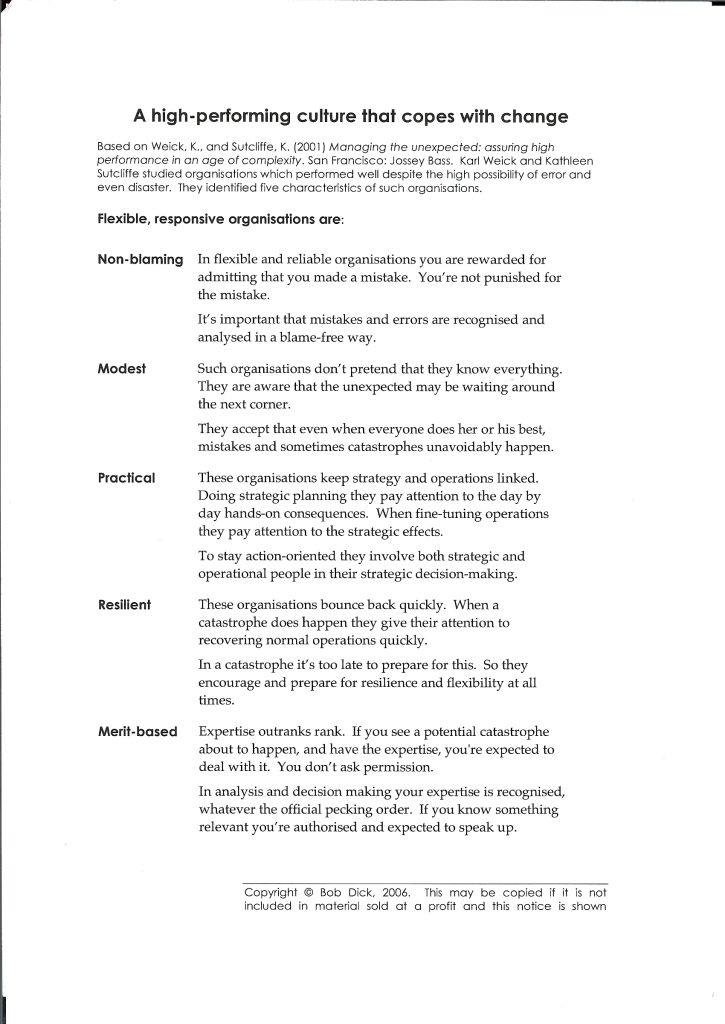Divergent ideas form a Convergent whole
Filed in Brain Science & Research, Facilitation, Living Systems & Complexity, Yes!And Improv
My last post described a game called Werewolf that I hosted for a group of people who, collectively, comprise an organisation. I worked with this team of people for 2 days. Day 1 was playful and Day 2 allowed the group to reflect on it’s own purpose and principles of working together.
Here are a set of resources that informed my processes and some of the thinking skills I brought to the group.
On Day 1 we played applied Improv games and learnt through a process of immersion in direct experience
Direct References – these ideas were shared directly with the group
1. Mindsight ideas from the work of Dr Daniel Siegel
2 rules that help to underpin Mindsight
Rule #1Being open to sensations in our bodies – gut, heart, head is a powerful source of knowledgeThese sensations shape the way we make rational decisionsBeing open to sub cortical sources is needed for clear mindsightRule #2Relationships are woven into the fabric of our interior worldWe come to know our our minds through our interactions with others and act quickly often without awarenessMindsight allows us to gain clarity about thes rapid sensations and information and gain new clarity about who we are
A podcast with Dr Daniel Siegel describing the Wheel of Awareness
An interview with Dr Daniel Siegel describing Mindfulness and Mindsight
2. Inner Game ideas from the work of Timothy Gallwey
On the tennis court, we practiced the art of ‘noticing’ the ball when throwing and catching in pairs. One group played the famous ‘bounce-hit’ game and another group played the ‘trajectory’ game.
I introduced the Inner Game concept of Self 1 and Self 2 (described further below). These quotes and summaries from Timothy Gallwey’s book The Inner Game of Work provide more insights into this approach to learning …
“There is always an inner game being played in your mind no matter what outer game you are playing. How aware you are of this game can make the difference between success and failure.” -Tim Gallwey
“Learning and performance are the same thing. People who win are those who learn faster. We learn fast when we pay attention to what is happening now – the present moment and for what the world really is and not what it could be. Learning becomes a function of attention and noticing more than instruction. It’s about noticing what is going on around you without judgement, fear. Or the need to control.” Peter Block from the Forward
“Self 1 the voice of making judgements and giving commonds – these are merely activities of the mind and not the true self. Self 1 doesn’t trust Self 2. This self doubt creates a poor learning environment. Self 2 is being spoken to by Self 1 and is the human being itself. It embodies all the human potential and possibly we are born with. It is our innate ability to learn from experiences and it is the self we enjoyed as children.” Chapter 1“The goal of the inner game is to reduce the interference to ones own potential. The goal of the outer game is to overcome external obstacles to reach our goals (eg. winning a tennis match). Inner and outer games are being played all the time, individually and as organizations and cultures. The outer game gets way more attention and our inner game (individually, culturally) is neglected.” Chapter 1.
My recent post also describes some of what we discussed and practiced here.
3. Complexity and the Cynefin Framework by Dave Snowden
Another post here by Chris Corrigan points to the need for a ‘Safe-Fail’ mindset when working in the complex domain.
4. Marshmallow Challenge
We played the Marshmallow Challenge and it’s lessons link back to the Safe-Fail approach when working in complexity. Here’s the TED Video that describes it in some detail …
5. Features of High Reliability Organisations
Here were the features I shared on Day 2 (Source: Training materials from Bob Dick)
These key features come from the research and (this) book by Weik & Sutcliffe – Managing the Unexpected: Assuring High Performance in an Age of Complexity.
They also have an article on Managing the Unexpected through Mindfulness which explores similar concepts and well worth a read.
Indirect References – these ideas informed my thinking when designing the 2 days
1. Michelle Holliday’s work on the Pattern of Living Systems
2. Gideon Rosenblatt’s take on the Systems Biology of Organisations
Day 2
Processes used to structure Day 2 conversations – there were other sub processes used too … too many to cover here 🙂
1. Chaordic Stepping Stones by Chris Corrigan over at the Art of Hosting
We used a handful of questions from the first 3 stepping stones of NEED, PURPOSE and PRINCIPLES
This is my favourite set of cards to elicit new ways of thinking and promote conversation between people.
Comments
Leave a Reply Cancel reply
You must be logged in to post a comment.


[…] Geoff Brown also talks about his inspiration from Mindsight here. […]